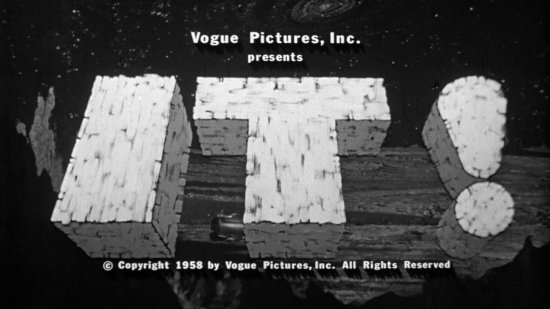Last week afforded my daughter and I another sci-fi movie night, and you, dear readers, get to hear all about it.
The mini-traveler was keen on trying out the new Drive-In, so I took the Chevy to the outskirts of town and pulled in between the screens. To my surprise, it seemed most of the attendees were families–apparently, our new outdoor cinema hasn't had time to turn into a Lover's Lane. To be fair, it also was a school night for most people.
Our first feature was a short–a cartoon about automotive safety in the guise of a portrayal of the future. We got to see cars of the year 2000 A.D. They will apparently have bubble canopies, automated guidance systems, fins, and be able to fly (in a limited fashion). I'm looking forward to those!

The main attraction was a film that came out late last year, the imaginately titled IT!. In a nutshell, because there honestly isn't much to this film, the first Martian mission (landed in 1972) has ended largely in failure. The six-person crew of the Challenger 141 has been reduced to just one: Captain Carruthers, and the Challenger 142 has been dispatched to pick him up–and try him for murder.
I guess the implication is that the Captain, realizing that his ship had been marooned and that there might not be enough food to feed all of the crew until rescue, decided to kill his crew to have the food to himself. It doesn't make a lot of sense, but it's an excuse for a little tension between Carruthers and the new ship's captain, Van.

But first, a little about the ship. As you can see, it's a typical rocket job, looking something like a V-2, but with rooms inside. Sensibly, the decks are arranged perpendicularly to the engine. Yet there is a throwaway line about "artificial gravity" that suggests anti-gravity has already been invented! I'm not sure why it matters how they lay out the ship then since the thrust of the engine is clearly far under the force exerted by the artificial gravity. Moreover, I'd think their artificial gravity would be a good propulsive element. Maybe it is… but it sure looked like standard fireworks under the ship's nozzle.

Anyway, back to the film. I was happy to see two women on the crew (one of whom gets involved in a love triangle between the Captains), though I noted they tended to be stuck with galley duty. At first I was concerned that they were the ship's maids, but it turned out they were actually the medical staff. And, of course, everybody smoked, even in the cramped space and clearly limited air supply. Welcome to the future!


Oh, you want to know the rest of the plot? In short, the eponymous "It" gets aboard the ship and starts killing the crew one by one, by dessication. The movie takes little time revealing the monster (thus exonerating Carruthers). My daughter noted sagely, "it would have been a lot cooler if they hadn't shown the monster." It's a pretty dopey looking humanoid monster suit. It's also well-nigh indestructible. Bullets and bazookas don't hurt it (and, of course, those are exactly the kinds of weapons I would use inside a small spaceship!), fire and gas only annoy it. It takes until the end of the movie for the bright lads to try venting the air to space and letting hard vacuum kill the Martian.



At this point, my observant daughter cried out, "Where are all these papers coming from?!" And that is one of the joys of the Drive-In: you can be as obnoxious as you wish, and no one is bothered. Living as we do in balmy Southern California, you can't beat the outdoor air-conditioning, either.
And, of course, the movie ends with a triumphant, happy, romantic ending.

Thus ends a very fluffy slightly-more-than-an-hour. My daughter enjoyed the special effects, and the cinematography is reasonably good. I would have expected a bit more meat from writer Jerome Bixby, however. Certainly not up to the standards of his famous story from six years ago, It's a Good Life. Maybe next time.
That wraps up this article, but I've got plenty more to say in upcoming installments. Tell me–what subjects hold the most interest for you? Reviews of digests? Book reviews? Movie critiques? Columns on the Space Race? Observations on life in general? Travelogues? I always like to keep my audience riveted.

And, by the by, I wish to give a public hello to my new friend, Bruce, with whom I conversed most pleasantly on scholarly topics at the local diner. A hep cat if I ever saw one. Dig those far out threads.
(Confused? Click here for an explanation as to what's really going on)
This entry was originally posted at Dreamwidth, where it has comments. Please comment here or there.
























